- About MAA
- Membership
- MAA Publications
- Periodicals
- Blogs
- MAA Book Series
- MAA Press (an imprint of the AMS)
- MAA Notes
- MAA Reviews
- Mathematical Communication
- Information for Libraries
- Author Resources
- Advertise with MAA
- Meetings
- Competitions
- Programs
- Communities
- MAA Sections
- SIGMAA
- MAA Connect
- Students
- MAA Awards
- Awards Booklets
- Writing Awards
- Teaching Awards
- Service Awards
- Research Awards
- Lecture Awards
- Putnam Competition Individual and Team Winners
- D. E. Shaw Group AMC 8 Awards & Certificates
- Maryam Mirzakhani AMC 10 A Awards & Certificates
- Two Sigma AMC 10 B Awards & Certificates
- Jane Street AMC 12 A Awards & Certificates
- Akamai AMC 12 B Awards & Certificates
- High School Teachers
- News
You are here
Who's That Mathematician? Paul R. Halmos Collection - Page 14
For more information about Paul R. Halmos (1916-2006) and about the Paul R. Halmos Photograph Collection, please see the introduction to this article on page 1. A new page featuring six photographs will be posted at the start of each week during 2012.
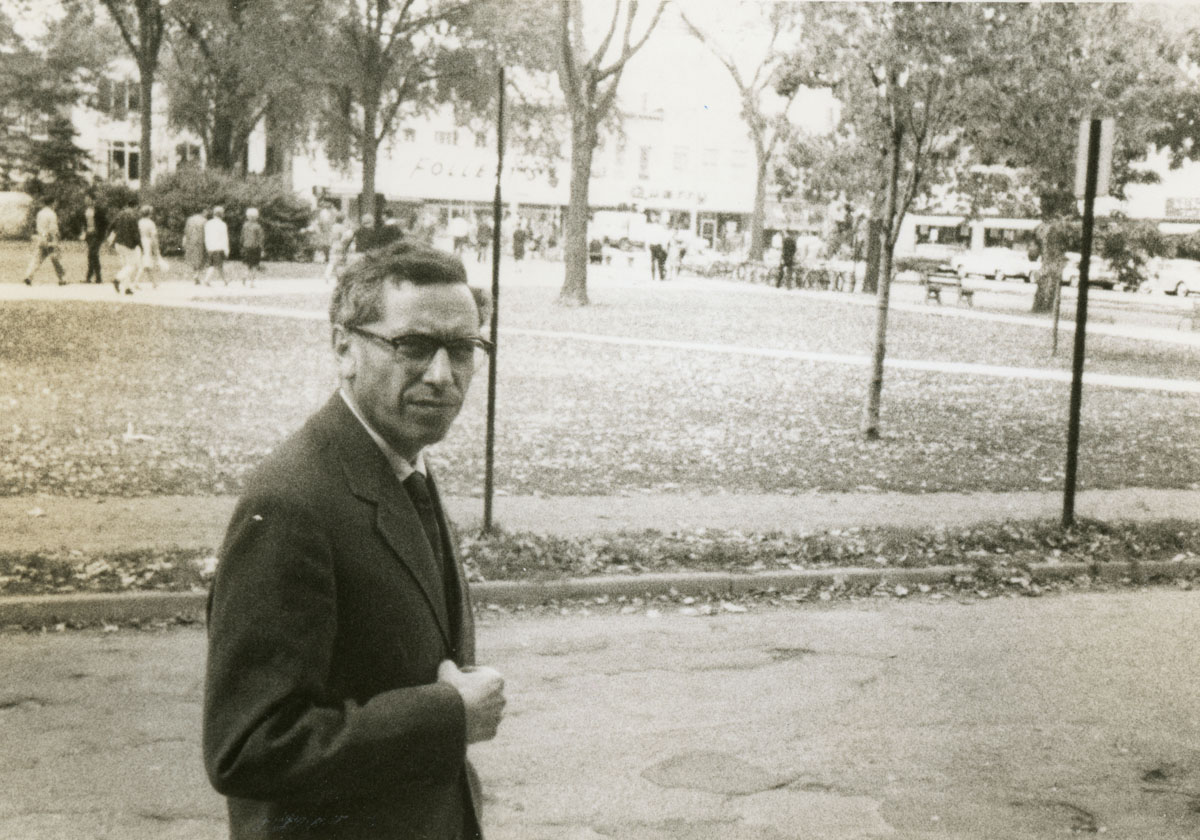
Halmos photographed Paul Erdös (1913-1996) in Ann Arbor, Michigan, in September of 1963. Halmos was a faculty member at the University of Michigan at the time. Erdös was well known for traveling all over the world posing and solving problems, mainly in number theory, combinatorics, and graph theory, with many and varied collaborators. According to one source, Erdös had been barred from the U.S. in 1954 (for showing too much enthusiasm for his homeland, Hungary, and for Karl Marx when interviewed by U.S. immigration agents) and was not allowed to return until November of 1963 (MacTutor Archive).
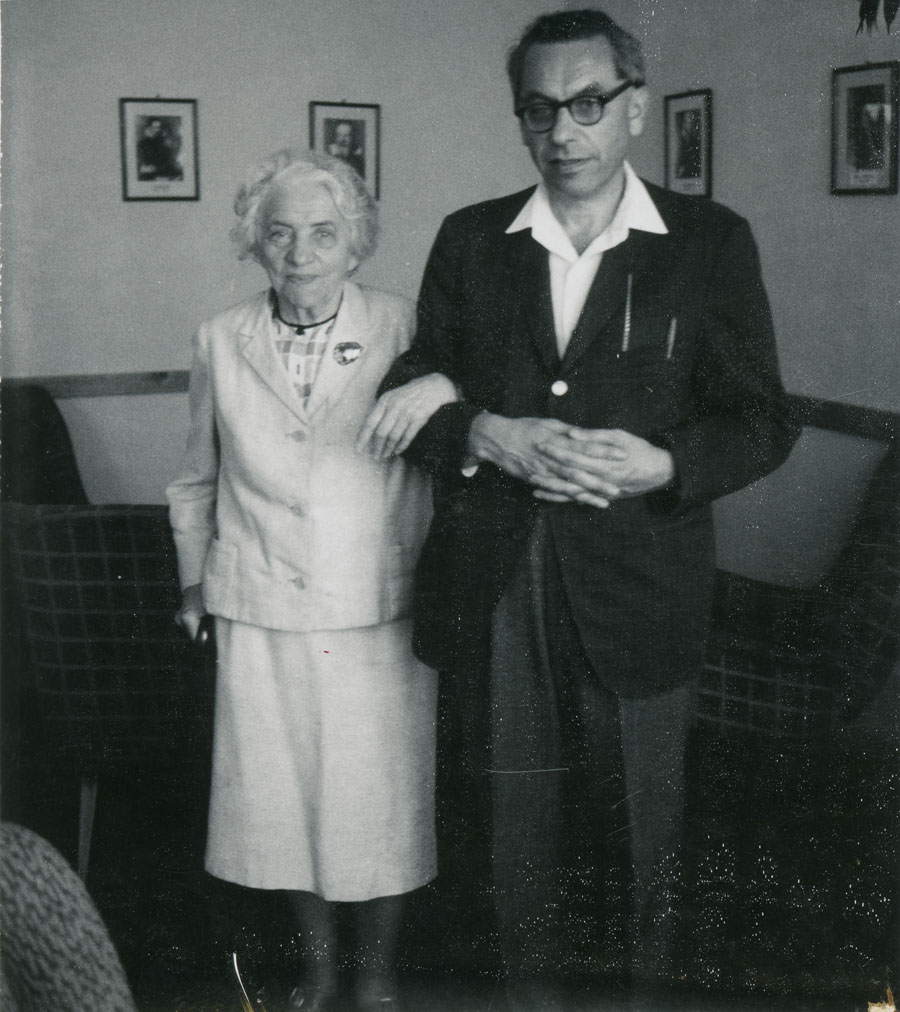
Paul Erdös and his mother, Anna Erdös, on July 12, 1968, in Budapest, Hungary, where Anna lived and where Paul was born. Erdös left Hungary just after earning his doctorate there in 1934 to become a post-doc at the University of Manchester in England. He was able to visit his family, who were Jewish, in Hungary until 1938 but had no news of them from 1941 to 1945. In 1945 he learned that his father had died in 1942 but that his mother had survived, and he finally was able to visit her in 1948 (MacTutor Archive). Erdös appears in another photograph on page 3 of this collection.
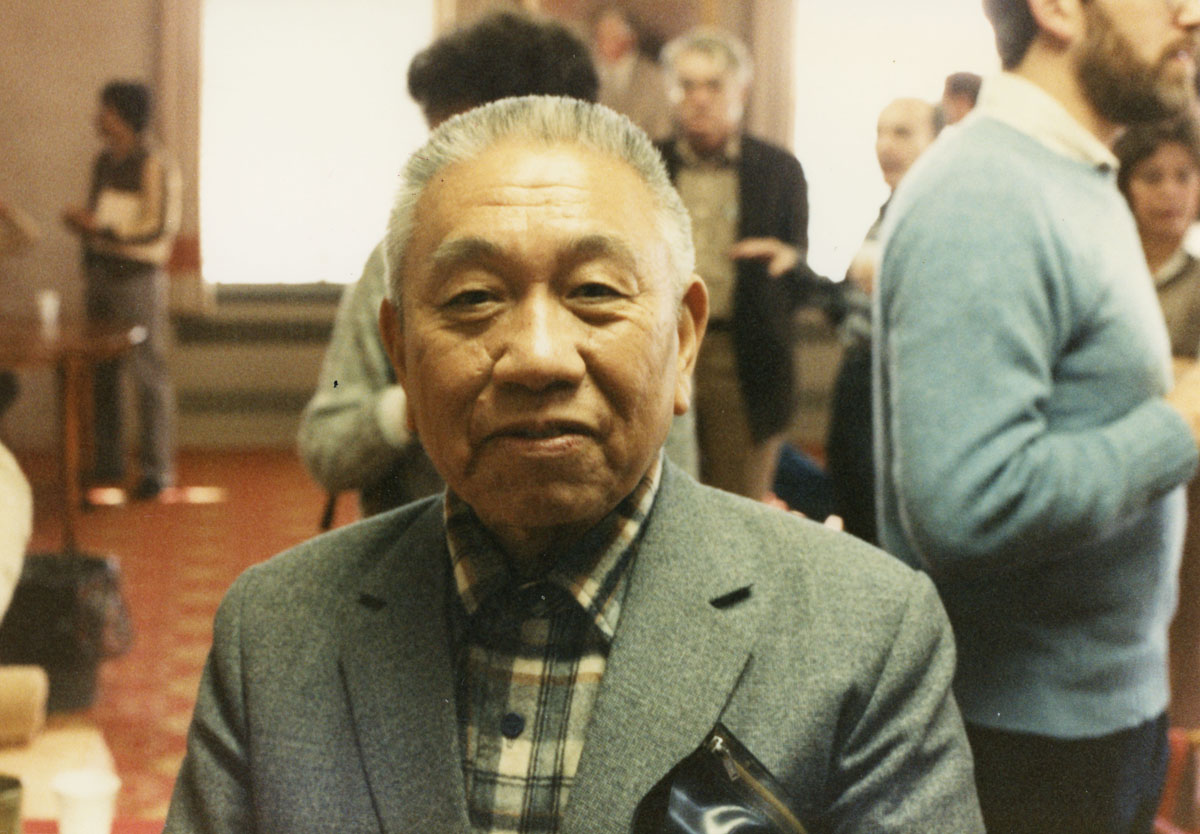
Ky Fan (1914-2010) was photographed by Halmos in 1985. Born in China, Fan studied mathematics at Peking University and then at the University of Paris, receiving his doctorate under Maurice Fréchet in 1941. He spent most of his career at the University of Notre Dame in South Bend, Indiana, and the University of California, Santa Barbara (UCSB). He contributed to many areas of analysis and topology and advised 21 Ph.D. students (UCSB). Fan and Halmos may have first met at the Institute for Advanced Study in Princeton, where Fan was a member from 1945 to 1947 and Halmos was a short-term visitor during 1945-46 (IAS).
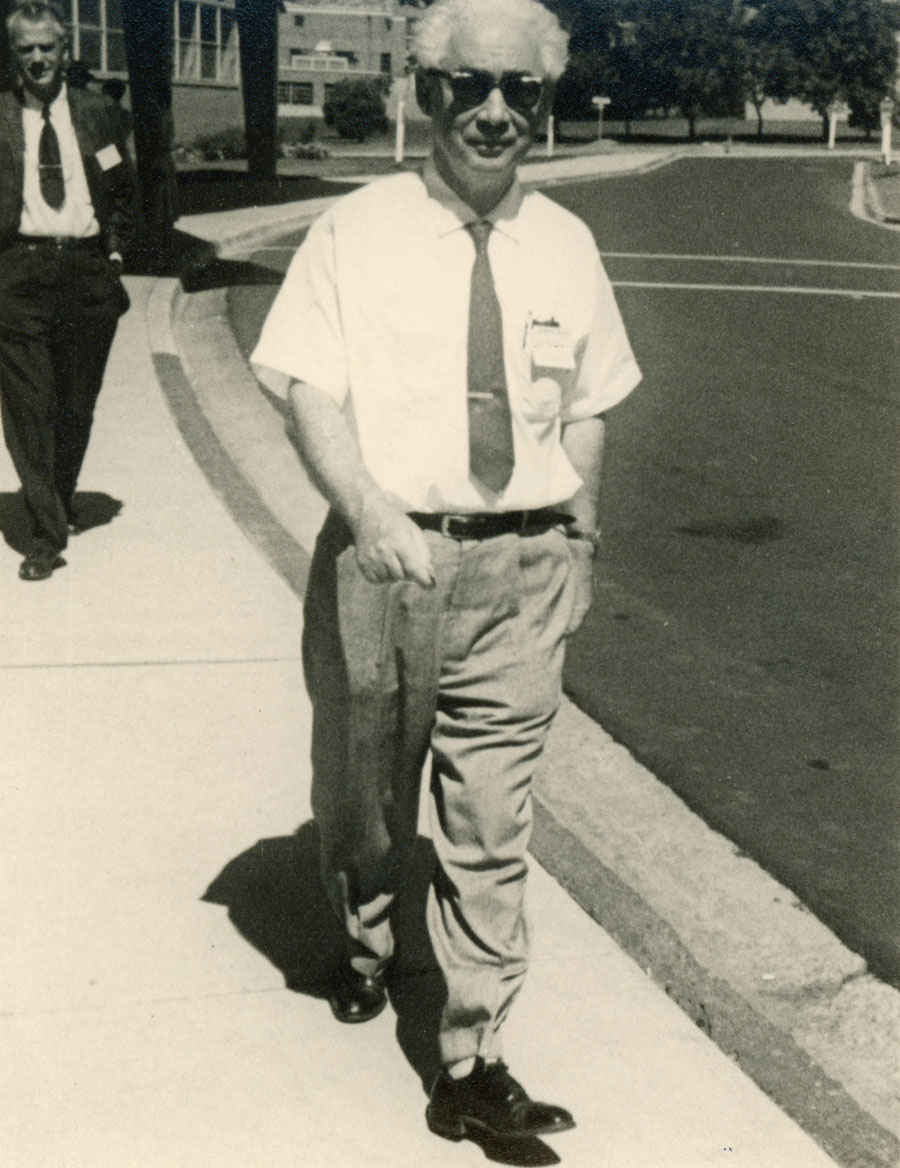
Halmos photographed two probabilists, Joseph Doob (1910-2004) (in background) and William Feller (1906-1970), in September of 1959. Doob was Ph.D. advisor to Halmos and appears in photographs on page 1, page 2, and page 12 of this collection. Born in Croatia, Feller studied mathematics at the University of Zagreb and then at Göttingen University in Germany, where he earned the Ph.D. in 1926 under David Hilbert and Richard Courant. He was able to work with probabilists Harald Cramér at the University of Stockholm during the 1930s and Mark Kac at Cornell University from 1945 to 1950. During the years 1939-1945, Feller was at Brown University in Providence, Rhode Island, where he helped Otto Neugebauer found Mathematical Reviews. He spent most of his career, from 1950 onward, at Princeton University (MacTutor Archive).

Leopold Flatto was photographed by Halmos in March of 1970 at Yeshiva University in New York City, where Flatto was a mathematics professor. Flatto earned his Ph.D. in 1955 from MIT with the dissertation “Periodic solutions associated with singular perturbations of a system of non-linear differential equations,” written under advisor Norman Levinson. He was at Yeshiva from 1961 to 1979 and at Bell Labs from 1979 to 1997. His best known books are Poncelet’s Theorem (AMS 2009) and the textbook Advanced Calculus (1976). When we asked him what spurred his interest in Poncelet's theorem, he wrote
While at Bell Labs I worked on some problems in queuing theory (double queues). I observed a connection between the latter and Poncelet's theorem .... So I got intrigued, both by the connection and by Poncelet's theorem. Being retired, I took up the study of Poncelet's theorem in earnest, and that explains my writing the book.
Flatto now teaches at City College of New York. (Sources: Mathematics Genealogy Project, WorldCat, CCNY Mathematics)
Halmos wrote “Flato” on the back of this photograph, leading us to believe at first that the photo was of Moshé Flato, cousin of Leopold Flatto and one of the few family members to spell his last name with only one “t”. Moshé Flato (1937-1998) was born in Tel Aviv and studied at Hebrew University in Jerusalem before moving to Paris in 1963, earning his doctorate in theoretical physics in 1965, and becoming a French citizen in 1967. A mathematical physicist, he was Professor of Mathematics at the University of Dijon from 1968 onward. (Source: MacTutor Archive)
We thank Daniel Sternheimer, Flato’s collaborator in mathematical physics from 1963 until his death, for correcting our mistaken identification. Sternheimer met Flatto several times, most recently at the International Congress of Mathematicians in Kyoto, Japan, in 1990. Sternheimer and Flato first met in 1958 in Israel in a distribution theory course taught by Shmuel Agmon. Sternheimer moved to Paris in 1961 to become a member of the Centre National de la Recherché Scientifique (CNRS) – initially to work with Agmon’s advisor Szolem Mandelbrojt – and retired from CNRS 42 years later! Since his retirement in 2003 he has lived mostly in Japan, as Visiting Professor of Mathematics at Keio University in Tokyo-Yokohama (2004-2010) and Visiting Research Fellow in Mathematics at Rikkyo University in Tokyo since 2010. Besides his Flato and Flatto connections, Sternheimer had his own Halmos connection:
Paul Halmos was a good friend of my uncle Richard Sternheimer, M.D., who lived in Chicago and was during WWII at the University [of Chicago], inter alia, the physician of the physicists of the Manhattan Project. Halmos made a list of mathematical textbooks that my uncle sent me when I immigrated to Israel in 1958. ... [M]y uncle Richard Sternheimer had many connections with the academic community in Chicago. In particular he remained the physician of the [Enrico] Fermi family. During WWII, he noticed a strange blood composition among the physicists (who were handling radioactive material) but they told him that the lab was taking care of that and he did not suspect anything (until Hiroshima) though he lived across the street from the first (underground) nuclear reactor!
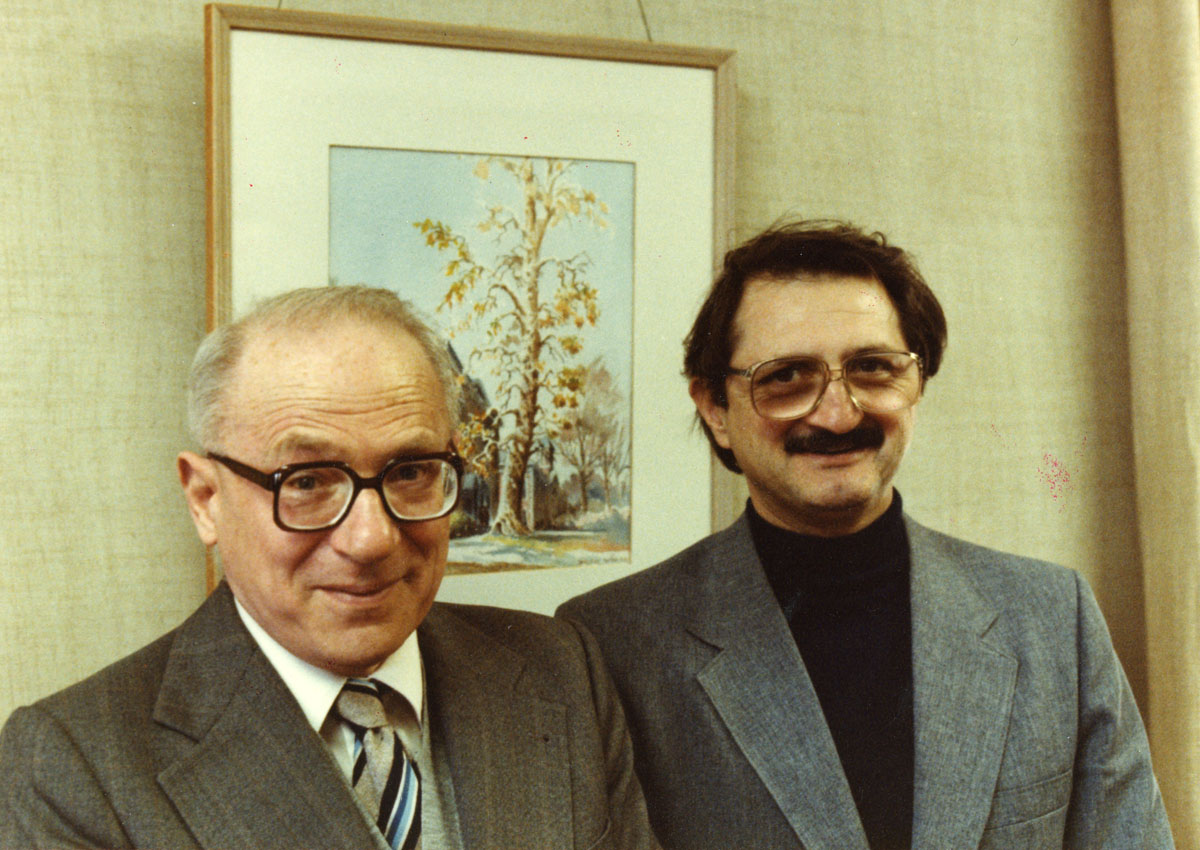
Halmos photographed Béla Szökefalvi-Nagy (1913-1998) and Ciprian Foias (1933-2020) at the Wabash Seminar in Crawfordsville, Indiana, in 1983. Szökefalvi-Nagy and Foias were longtime collaborators and co-authors of the book, Harmonic analysis of operators on Hilbert space, first published in French in 1967 and in English in 1970 (MathSciNet).
Szökefalvi-Nagy also appears in a photograph on page 9 of this collection, where you can read more about him. According to the Great Soviet Encyclopedia (3rd edition, 1979), Szökefalvi-Nagy "graduated from the University of Szeged, Hungary, in 1936 and became a professor there in 1948. ... [His] principal works deal with the approximation of functions and with functional analysis---in particular, the expansion of operators in [Hilbert] space" (The Free Dictionary). Sz.-Nagy also wrote articles on Hungarian mathematicians Frigyes (Frederic) Riesz, John von Neumann, and Alfred Haar (MathSciNet).
Foias is Distinguished Professor of Mathematics at Texas A & M University in College Station, specializing in PDEs and operator theory (Texas A&M). He also is Distinguished Professor Emeritus at Indiana University in Bloomington (Indiana University), where Halmos was a faculty member from 1969 to 1985. Foias joined the Indiana University mathematics faculty in 1979 after earning the Ph.D. at the Institute of Mathematics of the Romanian Academy in 1962 and serving as a mathematics professor at the University of Bucharest for 12 years. (Source: "1995 Norbert Wiener Prize in Applied Mathematics," AMS Notices 42:4, April 1995, pp. 457-458.)
For an introduction to this article and to the Paul R. Halmos Photograph Collection, please see page 1. Watch for a new page featuring six new photographs each week during 2012.
Regarding sources for this page: Information for which a source is not given either appeared on the reverse side of the photograph or was obtained from various sources during 2011-12 by archivist Carol Mead of the Archives of American Mathematics, Dolph Briscoe Center for American History, University of Texas, Austin.
Janet Beery (University of Redlands) and Carol Mead (Archives of American Mathematics, University of Texas, Austin), "Who's That Mathematician? Paul R. Halmos Collection - Page 14," Convergence (January 2012), DOI:10.4169/loci003801




